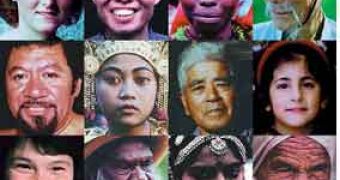This is really ambitious: a project attempting to track down all human language to a common oldest language ever, "alive" 50,000 years ago. It is then when Homo sapiens, who had emerged at least 150,000 years before, suddenly changed behavior. Until then, Homo sapiens was not very different from the Neanderthals. Both buried their dead, employed stone tools, and had some form of communication, mostly gestural.
"Almost overnight, everything changes very rapidly," said Dr. Merritt Ruhlen, a lecturer in the Anthropological Sciences Department at Stanford University in Palo Alto, Calif.
Humans started producing much better stone tools, creating art and burying their dead in a somewhat religious rite. "People started having imagination at this time much more than they had earlier," said Ruhlen.
Many researchers believe that fully modern human language enabled this breakthrough. Language is believed to have arisen just once, before the humans left Africa to colonize the world. It was then when all humankind spoke one language, dubbed "proto-world" or "proto-sapiens."
A multidisciplinary team led by Nobel Laureate physicist Murray Gell-Mannof at the Santa Fe Institute in New Mexico is developing the international Evolution of Human Languages (EHL) project, a freely accessible etymological database of the world's languages. EHL linguists are trying to reconstruct and then compare ancestor languages, moving closer and closer to the first human language.
But many linguists believe that historical languages cannot be studied beyond an 8,000-year threshold, as they change too much. And they say that a few common words among the reconstructed languages don't prove a link.
Speakers invent or borrow words continuously connected to their needs. But some languages change more than others. For example, Italian resembles much more the ancestral Latin than French. Lithuanian has many words that almost exactly match Sanskrit, spoken 3,500 years ago, opposite to its Latvian relative. Some language "families" like Afroasiatic (including Arab, Hebrew, Berber, Ancient Egyptian, Somali, Ethiopian) have words in common even after over 10,000 years of divergent evolution.
"That time limit is totally wrong. Languages that have been separated 8,000 years get down to a low percentage of common words. However, that low percentage seems to be very stable." said John Bengtson, vice president of the Association for the Study of Language in Prehistory in Cambridge, Mass.
Within languages, some crucial words - like the pronoun "we" and the number "one" - are much less likely to change or be lost.
They EHL investigates "words that are thoroughly essential and must have been in human language before significant cultural advances were made," wrote co-author George Starostin, a linguist at the Russian State University for the Humanities in Moscow. This method has grouped all the world's languages into 12 linguistic superfamilies. Four of these superfamilies, including languages of Eurasia, North Africa, and some Pacific islands, and perhaps Americas too, were grouped into one super-superfamily named "Borean".
An ancestor to most of today's languages, Borean was spoken some 16,000 years ago when glaciers covered much of Europe and North America.
The researchers believe that 20,000 years ago, at the peak of the last ice age, the world's languages were very diverse, but the glaciers pushed humanity south, mixing linguistic groups together. Only a few languages survived this mixture, and Borean is believed to have been one of them.
One method involved words and meanings across languages. "A word roughly corresponding to "water," which they render in proto-sapiens as "AQWA," appears in many languages. In Latin it's "aqua"; in Japanese, "aka" means "bilge water"; in Chechen, meanwhile, "aq" means "to suck"; in an African Kung (bushmen) dialect, "kau" means "to rain"; and in Central American (Maya) Yucatec, "uk" means "to be thirsty."", said Statostin.
But critics say that there's a very loose connection between the words and their meanings and sounds, and could have been borrowed from one language to another or it also can be onomatopoetic (like "Cock-a-doodle-doo", that appears in similar form in many languages, but without any proven relation.). Moreover, shorter words of just one syllable rather than two or three are more likely to find a match.
"You've presented this list of words, but it looks like you can explain these lists in several different ways. Their data is really easy to challenge, and it's really easy to find words that are similar to one another across languages," said Lyle Campbell, a professor of linguistics at the University of Utah in Salt Lake City.
But the same method was used by Sir William Jones, who in the 18th century first postulated a common ancestral language for classical Greek, Latin, and Sanskrit. Now the Indo-European family is one of the most widely accepted language family.
Historical linguistics starts by observing similarities that take place more frequently than dictated by chance. "It is more risky because you're comparing two or more hypotheticals to arrive at an even more hypothetical construction, but we think it's still a valid thing to try to do." said Bengtson.
EHL's basic assumptions are supported by genetics. All humans seem to originate in a pool of 1,000 individuals living between 50,000 and 60,000 years ago, explaining why the languages spread so quickly. "Bottlenecks play a very important part in human evolution. This was the first major bottleneck." said Ruhlen.
Genetics shows two separate migrations out of Africa: a southern one following south coast of Asia, who reached Australia at least 45,000 years ago. The other followed the land route through the Middle East into Central Asia, from where they headed both west into Europe and east, even to the Americas.
EHL has assigned the world's languages into three super-superfamilies linked to these migrations: those of the coastal route, which include Papuan and Australian languages; the Borean for the Cental Asian route and the "click" languages spoken by the San (Bushmen) of southern Africa.
The San languages, unique through their use of click sounds, could be a relict from proto-sapiens.

 14 DAY TRIAL //
14 DAY TRIAL //